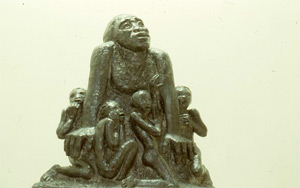
Born in Yorkshire England, Edna Manley's mother was Jamaican, from the prominent Shearer family. She met her cousin Norman Manley who had come to England as a Rhodes scholar to study at Oxford. He was later conscripted and fought in WW1, while Edna studied at St Martina's School of Art. They married in 1922 and moved to Jamaica where Edna was to pursue her career as a sculptor creating images that reflected Jamaica's struggle for nationhood. During the 1930's Edna Manley continued to exhibit in London but increasingly her focus was Jamaica where she exhibited and supported the development of the arts.
Edna Manley's Negro Aroused (1935) aptly reflects her stylistic and social interests during that era. Hewn intentionally from dark mahogany, its naked black torso supports a head thrust upwards in search of a new dawn. Stylistically, "Negro Aroused" is linked to William Blake's romantic imagery of a renovated or resurrected man (Boxer, 1990), but conceptually it wrestles with edenic and primordial thinking closer to the primitivists Henry Moore and Barbara Hepworth. Yet, in spite of its idealism, Negro Aroused is a constrained and even pained figure. Even without chains, its movement is frustrated by its rooted akimbo posture, suggesting that the black man's future is not born out of freedom but an irrevocable recognition of place. Norman Manley considering how the black man might triumph over this adversity wrote: "...There is a tremendous difference between living in a place and belonging to it and feeling that your own life and destiny is irrevocably bound up in the life and destiny of that place. It is that spirit which is the most hopeful thing in Jamaica today. It is that spirit which alone encourages the development of our national consciousness..."
Sculptures such as Negro Aroused (1936) became icons for this era and much of the work that she created in the run up to Jamaica's independence such as "Into the Sun" (1954), "Growth" (1958) and "I Saw My Land" (1960) featuring the same heroic black figure, bear this weight of representing the nation's vision.
Her message promoted black self-dignity, but never at the expense of personal and autobiographical details. The Moses images from the 1950s suggest how her personal and public life were entwined once her husband Norman Manley became Jamaica's Chief Minister. Edna Manley's images of the prophet Moses bear strong resemblance to her husband Norman, while the narrative imagery of works like I Saw My Land (1960) boldly signal his role as deliverer of the nation. The designation "Moses" was an appropriate one in a society that saw itself as being freed from bondage and colonialism and set on a path for Independence. As part of her efforts to support the national development Edna taught art classes and helped to establish the Jamaica School of Art and Crafts (1950) through which she influenced later generations of artists. Her husband became Chief Minister of Jamaica in 1954 and although he lost the national elections in 1961, he was instrumental in leading Jamaica to Independence in 1962. Norman Manley died in 1969, but was succeeded by their son Michael who became Prime Minister in 1972. Edna continued to play an active role in cultural development as a founder member of the National Gallery of Jamaica and as one of the countries foremost artists winning numerous awards and national commissions and sculpting an enormous body of work, right up until her death at age 85.
